How Do I Create a Drought-tolerant Garden?
As summers heat up, plants that need less water are increasingly desirable. Luckily, there are lots of beautiful options
As we all become more eco-aware, and our weather gets warmer, any garden that requires less watering has to be a good thing, right? Luckily, there are lots of tips for creating a garden that won’t require an irrigation system or daily dates with the hose, but will still look beautiful. From soil preparation to plant choices, here’s what three garden experts suggest for making your garden self-sustainable.
Professional advice from: Toby Diggens at Digg & Co; Julia Cody at Hamilton Cody Garden Design; Simon Orchard at Simon Orchard Garden Design
Professional advice from: Toby Diggens at Digg & Co; Julia Cody at Hamilton Cody Garden Design; Simon Orchard at Simon Orchard Garden Design
Lesson 1: Let nature flourish
Minimalist – and often thirsty – garden design is on the way out, Toby believes. Instead, he says, “We should all be enjoying the naturalness of our gardens more and potentially tidying and primping them less.
“One thing we could all do is reduce the amount of fossil fuel-based activities, such as hedge-cutting and mowing, that we do,” he continues. Instead, we could be letting our grass grow long while encouraging any wildflowers within the sward to bloom. “You could then just cut it back or mow useful paths, areas where children could play, or places where you could have a barbecue,” he says.
“Similarly, why not try your hand at hedge-laying?” Toby suggests, referring to the traditional craft that involves a form of pleaching shrubs and small trees to create a hedge structure. This tends to work best in larger, non-urban gardens. See below for a photo to illustrate the technique.
Minimalist – and often thirsty – garden design is on the way out, Toby believes. Instead, he says, “We should all be enjoying the naturalness of our gardens more and potentially tidying and primping them less.
“One thing we could all do is reduce the amount of fossil fuel-based activities, such as hedge-cutting and mowing, that we do,” he continues. Instead, we could be letting our grass grow long while encouraging any wildflowers within the sward to bloom. “You could then just cut it back or mow useful paths, areas where children could play, or places where you could have a barbecue,” he says.
“Similarly, why not try your hand at hedge-laying?” Toby suggests, referring to the traditional craft that involves a form of pleaching shrubs and small trees to create a hedge structure. This tends to work best in larger, non-urban gardens. See below for a photo to illustrate the technique.
“Essentially, you pare the main stem back by removing side shoots, then half cut the base stem and leave an area of living tree attached to the base. You then fold the stem over on its side and ‘lay’ it down by using a stake to hold it in place. It can be done very attractively,” Toby says.
Over the next four to five years, the hedge grows thick and tall. “The long rest period for the hedge locks up carbon, supports far more wildlife, and allows dappled shade, which reduces the need for watering in high summer,” he says.
There are lots of websites dedicated to the craft with how-to videos and photos.
Need an expert to help you rethink your planting? Check out reviews of garden designers in the Houzz Professionals Directory.
Over the next four to five years, the hedge grows thick and tall. “The long rest period for the hedge locks up carbon, supports far more wildlife, and allows dappled shade, which reduces the need for watering in high summer,” he says.
There are lots of websites dedicated to the craft with how-to videos and photos.
Need an expert to help you rethink your planting? Check out reviews of garden designers in the Houzz Professionals Directory.
Lesson 2: Prepare your soil
The professionals also underline the importance of soil preparation. Organic matter – compost, manure, garden waste, organic fertiliser – is key for a soil that will be as self-sufficient as possible.
The experts point repeatedly to Beth Chatto’s famous gravel garden, which is never watered, as a model of sustainable planting. “They conditioned the soil a lot before planting, watered it – then left it. It’s amazing,” Julia Cody says, adding that Beth Chatto also wrote a book about the garden and drought-resistant gardening that’s worth a look.
“Round here we have a lot of really dense clays – organic matter and grit, which bakes really hard in summer,” Julia says. “There’s also thin, river-gravel soil that doesn’t hold moisture, either. It’s really good for Mediterranean plants, but we put down organic matter for them and every soil needs that.”
Toby adds a warning against using weedkillers.“I know it’s easy just to eradicate issues with them, but who knows what you’re actually doing to your soil biology, as well as to birds and mammals?” he says.
More: What’s the Best Way to Kill Weeds Naturally?
The professionals also underline the importance of soil preparation. Organic matter – compost, manure, garden waste, organic fertiliser – is key for a soil that will be as self-sufficient as possible.
The experts point repeatedly to Beth Chatto’s famous gravel garden, which is never watered, as a model of sustainable planting. “They conditioned the soil a lot before planting, watered it – then left it. It’s amazing,” Julia Cody says, adding that Beth Chatto also wrote a book about the garden and drought-resistant gardening that’s worth a look.
“Round here we have a lot of really dense clays – organic matter and grit, which bakes really hard in summer,” Julia says. “There’s also thin, river-gravel soil that doesn’t hold moisture, either. It’s really good for Mediterranean plants, but we put down organic matter for them and every soil needs that.”
Toby adds a warning against using weedkillers.“I know it’s easy just to eradicate issues with them, but who knows what you’re actually doing to your soil biology, as well as to birds and mammals?” he says.
More: What’s the Best Way to Kill Weeds Naturally?
Lesson 3: Protect your soil
Simply having good soil to start with is not enough. Protecting that soil is just as important – and the gravel in the already-mentioned Beth Chatto garden, for example, is there to do that job.
“Mulch, mulch, mulch,” Simon advises. “Whether bark or gravel, it helps slow evaporation of water from the soil.”
“The key is to remove bare ground,” Toby adds, pointing to the use of either an organic or natural mulch. He also suggests strategic planting. “High plant densities with varying rooting depths will enable good soil moisture year-round, as the soil won’t be exposed to the desiccating sun.”
Simply having good soil to start with is not enough. Protecting that soil is just as important – and the gravel in the already-mentioned Beth Chatto garden, for example, is there to do that job.
“Mulch, mulch, mulch,” Simon advises. “Whether bark or gravel, it helps slow evaporation of water from the soil.”
“The key is to remove bare ground,” Toby adds, pointing to the use of either an organic or natural mulch. He also suggests strategic planting. “High plant densities with varying rooting depths will enable good soil moisture year-round, as the soil won’t be exposed to the desiccating sun.”
Lesson 4: Practise tough love
If you ‘spoil’ your plants by watering them generously, they’ll come to expect (and need) regular drinks, say the experts.
“If you treat them mean from the get-go, they’ll learn to survive better,” Simon says. He points, as an example, to irrigation systems as a factor that can create thirsty plants. “The plants get ‘lazy’, because they’re not used to holding the water. Whereas if they’ve always had to put out roots to find water, they’ll become more robust for these hotter, drier summers we’re having.” However, when starting plants off, he says, they may need generous watering to help the roots establish.
Julia echoes this point, and also says a good soaking now and then is better for creating self-sufficient plants than daily watering. “It helps them to really get as independent as possible, to get their roots down looking for their own source, rather than looking near the surface,” she says.
“Making the plants work hard to survive sounds harsh, but if you train them to the hose, they will never deal with a drought,” Toby agrees. “Obviously, this has to be taken with a bit of common sense – if they’re actually dying, then you’ll need to step in – but consider their location and habitat and don’t be afraid to move things if you realise they’re in the wrong place.”
More: Meet the Designers Championing Sustainable ‘Brownfield’ Gardens
If you ‘spoil’ your plants by watering them generously, they’ll come to expect (and need) regular drinks, say the experts.
“If you treat them mean from the get-go, they’ll learn to survive better,” Simon says. He points, as an example, to irrigation systems as a factor that can create thirsty plants. “The plants get ‘lazy’, because they’re not used to holding the water. Whereas if they’ve always had to put out roots to find water, they’ll become more robust for these hotter, drier summers we’re having.” However, when starting plants off, he says, they may need generous watering to help the roots establish.
Julia echoes this point, and also says a good soaking now and then is better for creating self-sufficient plants than daily watering. “It helps them to really get as independent as possible, to get their roots down looking for their own source, rather than looking near the surface,” she says.
“Making the plants work hard to survive sounds harsh, but if you train them to the hose, they will never deal with a drought,” Toby agrees. “Obviously, this has to be taken with a bit of common sense – if they’re actually dying, then you’ll need to step in – but consider their location and habitat and don’t be afraid to move things if you realise they’re in the wrong place.”
More: Meet the Designers Championing Sustainable ‘Brownfield’ Gardens
Lesson 5: Water sustainably
It’s not just about watering plants more sparingly, it’s also about what to water them with, as Simon reminds us.
“Everybody should have a water butt. Even if you have the tiniest shed or greenhouse, take any opportunity to harvest water you can,” he says. And they don’t have to be unsightly. “You can get water butts that have planters on top of them,” he says. “These days, they can easily be made into a feature.”
It’s not just about watering plants more sparingly, it’s also about what to water them with, as Simon reminds us.
“Everybody should have a water butt. Even if you have the tiniest shed or greenhouse, take any opportunity to harvest water you can,” he says. And they don’t have to be unsightly. “You can get water butts that have planters on top of them,” he says. “These days, they can easily be made into a feature.”
Lesson 6: Choose the right plants
“Do plenty of research before letting yourself run free in the plant nursery,” Toby says. “All those colours are there to attract you!”
As a general rule, Simon advises going for silver-leaved plants, such as lavender. “The silver reflects the sunlight and this feature is often a good sign a plant will be drought-tolerant,” he says.
He also points to both small and hairy leaves, which retain water, as great qualities in self-sustainable varieties. “A plant with all three – silver, small-leaved and hairy – is a great combination,” he says.
“Most of the plants we use in domestic landscapes come from different areas of the world,” Toby says. “It’s one of our design principles to understand these native landscapes and then emulate the plant communities in such as way as to suit them best. This leads to less watering and maintenance and much longer-lived plantings.”
“We are working on planting that’s more self-sufficient,” Julia says. “For example, I’m the trustee of a nature reserve, where we’re creating some planters outside in full sun. We’re planting Mediterranean herbs – thyme, sage, rosemary and so on – that can survive with a lot less watering.”
“Do plenty of research before letting yourself run free in the plant nursery,” Toby says. “All those colours are there to attract you!”
As a general rule, Simon advises going for silver-leaved plants, such as lavender. “The silver reflects the sunlight and this feature is often a good sign a plant will be drought-tolerant,” he says.
He also points to both small and hairy leaves, which retain water, as great qualities in self-sustainable varieties. “A plant with all three – silver, small-leaved and hairy – is a great combination,” he says.
“Most of the plants we use in domestic landscapes come from different areas of the world,” Toby says. “It’s one of our design principles to understand these native landscapes and then emulate the plant communities in such as way as to suit them best. This leads to less watering and maintenance and much longer-lived plantings.”
“We are working on planting that’s more self-sufficient,” Julia says. “For example, I’m the trustee of a nature reserve, where we’re creating some planters outside in full sun. We’re planting Mediterranean herbs – thyme, sage, rosemary and so on – that can survive with a lot less watering.”
Julia adds that dry conditions in full shade can be trickier when it comes to planting and, again, refers to the importance of soil conditioning. She flags up the Dryopteris family of ferns (pictured) as one that thrives in full shade and copes well with little water.
Plant picks
To further inspire, here’s just a tiny selection of plants you might consider for starters – depending on where you live, of course – to help you create your own drought-tolerant garden.
Bergenia These can do well in dry shade. “They are tough and reliable, they flower really well, and their leaves can go from green to bronzy-red in the winter,” Julia says. “I particularly like the smaller ones, such as ‘Silberlicht’ and ‘Harzkristall’.
To further inspire, here’s just a tiny selection of plants you might consider for starters – depending on where you live, of course – to help you create your own drought-tolerant garden.
Bergenia These can do well in dry shade. “They are tough and reliable, they flower really well, and their leaves can go from green to bronzy-red in the winter,” Julia says. “I particularly like the smaller ones, such as ‘Silberlicht’ and ‘Harzkristall’.
Sarcococca “This is another plant we use in difficult areas,” Julia says. “It’s not much to look at, but it’s really tough and has tiny but powerfully scented flowers in the winter. It can scent a large area of the garden and tempt you outside.
“There are lots of varieties, large and small,” she adds. “We often go for S. hookeriana var. digyna, because it’s not too large and it has attractive, narrow foliage.”
“There are lots of varieties, large and small,” she adds. “We often go for S. hookeriana var. digyna, because it’s not too large and it has attractive, narrow foliage.”
Echium vulgare “A beautiful biennial,” Toby says of this delicate purple flowering plant.
Achillea “This is amazingly diverse in the habitats it can tolerate,” Toby says. “And all the cultivars means there’s always a good one for a scheme.”
A. millefolium can be seen in this garden just behind the pink Echinacea pallida.
A. millefolium can be seen in this garden just behind the pink Echinacea pallida.
Daucus carota More commonly known as wild carrot, this plant, says Toby, “has amazing foliage and amazing flowerheads”.
Scabiosa columbaria “Native scabious provides food for so many butterflies,” Toby says. “A definite future plant of our gardens.”
Tell us…
Which plants and ways of planting have helped you to water your garden less? Share your tips in the Comments.
Tell us…
Which plants and ways of planting have helped you to water your garden less? Share your tips in the Comments.





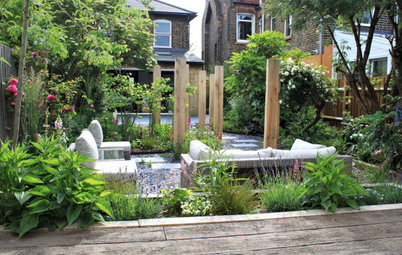
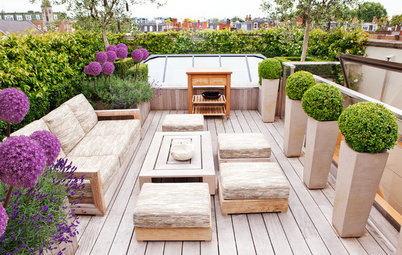
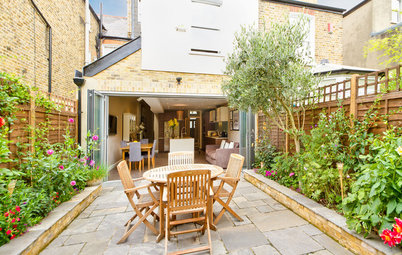
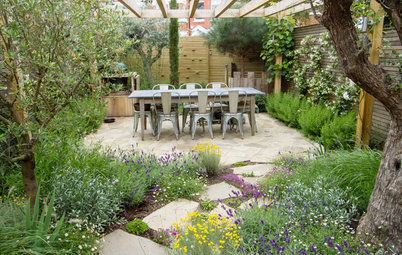
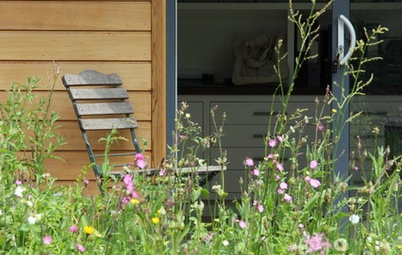
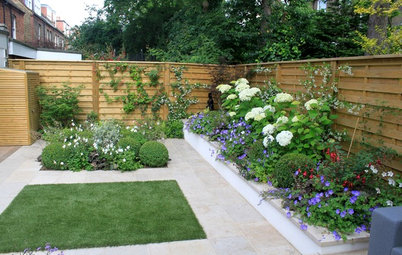
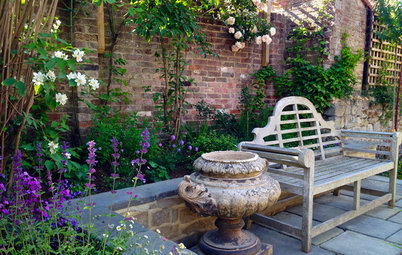
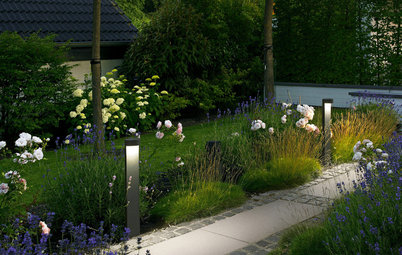
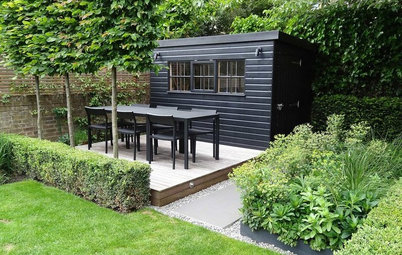

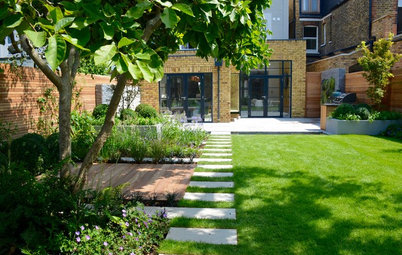
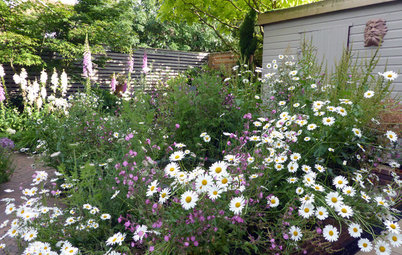
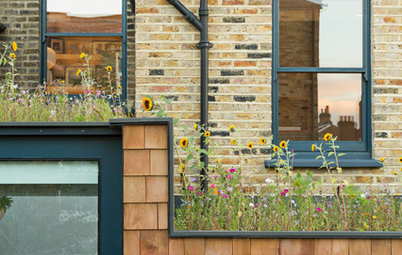
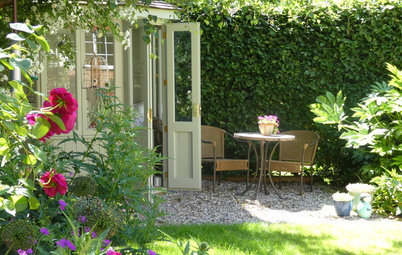
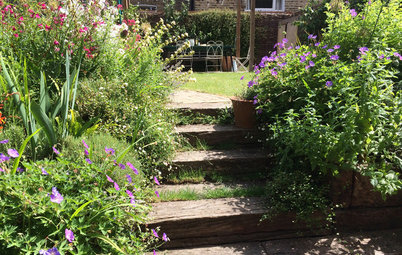

All three professionals agree that ‘drought gardening’ – creating gardens tailored to withstand hot, dry weather – is something they’re increasingly having to take into consideration in their work.
“While I haven’t designed any specific drought-tolerant gardens,” Simon Orchard says, “in the times we’re in, it’s really important to try to work with what we’ve got and with plants that are more suitable.”
This, he says, has really changed in the past 20 years. For example, it’s easier now to grow a lot more Mediterranean plants; he cites an Albizia tree, long common in southern European countries, that he recently planted in a London garden. “A decade ago, that wouldn’t have been seen in the UK,” he says.
“Drought tolerance is something we always look to achieve when designing landscapes; it comes down to the specific soils and needs of the site as to whether we deem it a key design feature,” Toby Diggens says. “When working in the east of England, it’s become especially relevant to work with more natural landscape types.”
Here are the experts’ top line drought-resistant gardening tips in six simple lessons, followed by some useful plant suggestions.